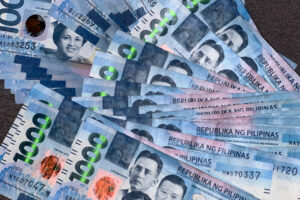Philippine peso’s rally faces test from widening trade deficit

The Philippine peso’s advance fueled by bets on further rate hikes by the nation’s central bank could face headwinds from a widening trade deficit.
The peso, which has risen 1.9% this year to become the top performer in Asia, is forecast to be at 54.80 per dollar by the end of June, near the level where it’s trading at now, according to the median estimate in a Bloomberg survey.
The currency is under pressure from outflows after a drop in exports pushed the Philippine trade shortfall to the widest in five months. That’s even as the peso is supported by expectations Bangko Sentral ng Pilipinas will deliver another rate hike this week as it remains one of the few monetary authorities in Asia to retain a tightening bias.
“The peso will soon lag its regional peers,” said Eugenia Victorino, head of Asia strategy at Skandinaviska Enskilda Banken AB in Singapore. “The trade deficit will remain huge as the global recession cuts into exports. That means there is still more dollar outflow and it will definitely put pressure on the currency.”
Survey forecasts were mixed with Standard Chartered Plc being the most bearish with expectations for the currency to depreciate to 57 per dollar while ING Groep NV predicted the currency will rally to 53.3 to the greenback.
The Philippine central bank forecasts a current-account deficit of $17.1 billion this year, which is 4% of gross domestic product, reflecting an elevated trade shortfall.
HIGHER CARRY
Currency traders will be focused on the BSP as all but one of the 18 analysts surveyed by Bloomberg predict the central bank will lift its key rate by 25 basis points on Thursday after it was tripled in the past year to 6%. Those rate increases are retaining the yield premium of local bonds over US debt, even after the Federal Reserve’s 450 basis points of hikes since March 2022.
“The relatively higher carry allure could be one tailwind to fight any yield-driven dollar strengthening,” said Stephen Chiu, chief Asia FX and rates strategist at Bloomberg Intelligence in Hong Kong. “If the Fed ends up having to hike to a higher terminal rate, the peso may be added to a portfolio to boost carry.”
That’s likely to somewhat neutralize the risk for the peso from the Fed meeting this week as troubles in the US banking sector have muddied the outlook for central bank policy.
“There’s scope for the peso to remain strong, particularly as BSP is keen on maintaining a healthy interest-rate differential with the US to anchor the currency and inflation,” said Michael Ricafort, chief economist at Rizal Commercial Banking Corp. in Manila. “But with the rising uncertainty in the global environment, there will be swings along the way before the peso posts a convincing upward trend.” — Bloomberg




